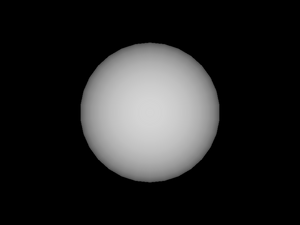Table of Contents
This chapter is an overview of VRML concepts. It describes the language from the point of view of VRML author. It teaches how a simple VRML files look like and what are basic building blocks of every VRML file. It's intended to be a simple tutorial into VRML, not a complete documentation how to write VRML files. If you want to learn how to write non-trivial VRML files you should consult VRML specifications.
This chapter also describes main differences between VRML 1.0, 2.0 (also known as VRML 97) and 3.0 (more widely known as X3D). Our engine currently handles all these VRML versions. However, at the time of initial writing of this document, our engine supported only VRML 1.0 and basic 2.0, so more advanced and interesting VRML 2.0 and X3D concepts are only outlined at the end of this chapter — maybe this will be enhanced some day.
VRML files are normal text files, so they can be viewed and edited in any text editor. Here's a very simple VRML 1.0 file that defines a sphere:
#VRML V1.0 ascii
Sphere { }The first line is a header. It's purpose is to identify
VRML version and encoding used. Oversimplifying things a little,
every VRML 1.0 file will start with the exact same line:
#VRML V1.0 ascii.
After the header comes the actual content.
Like many programming languages, VRML language is a free-form
language, so the amount of whitespace in the file doesn't really matter.
In the example file above we see a declaration of a node
called Sphere. “Nodes” are the building
blocks of VRML: every VRML file specifies a directed graph of nodes.
After specifying the node name (Sphere),
we always put an opening brace (character {),
then we put a list of fields and
children nodes of our node,
and we end the node by a closing brace (character }).
In our simple example above, the Sphere
node has no fields specified and no children nodes.
The geometry defined by this VRML file is a sphere centered at the origin of coordinate system (i.e. point (0, 0, 0)) with a radius 1.0.
Why the sphere is centered at the origin?
Spheres produces by a
Spherenode are always centered at the origin — that's defined by VRML specifications. Don't worry, we can define spheres centered at any point, but to do this we have to use other nodes that will move ourSpherenode — more on this later.Why the sphere radius is 1.0?
This is the default radius of spheres produced by
Spherenode. We could change it by using theradiusfield of aSpherenode — more on this later.
Since the material was not specified, the sphere will use the default material properties. These make a light gray diffuse color (expressed as (0.8, 0.8, 0.8) in RGB) and a slight ambient color ((0.2, 0.2, 0.2) RGB).
An equivalent VRML 2.0 file looks like this:
#VRML V2.0 utf8
Shape {
geometry Sphere { }
}
As you can see, the header line is now different. It indicates VRML version as 2.0 and encoding as utf8 [1].
In VRML 2.0 we can't directly use a Sphere
node. Instead, we have to define a Shape node
and set it's geometry field to our desired
Sphere node. More on fields and children nodes
later.
Actually, our VRML 2.0 example is not equivalent to VRML 1.0 version: in VRML 2.0 version sphere is unlit (it will be rendered using a single white color). It's an example of a general decision in VRML 2.0 specification: the default behavior is the one that is easiest to render. If we want to make the sphere lit, we have to add a material to it — more on this later.
[1] VRML 2.0 files are always encoded using plain text in utf8. There was a plan to design other encodings, but it was never realized for VRML 2.0. VRML 2.0 files distributed on WWW are often compressed with gzip, we can say that it's a “poor-man's binary encoding”.
X3D (VRML 2.0 successor) filled the gap by specifying three encodings available: “classic VRML encoding” (this is exactly what VRML 2.0 uses), an XML encoding and a binary encoding. Our engine currently handles XML and classic X3D encoding.

